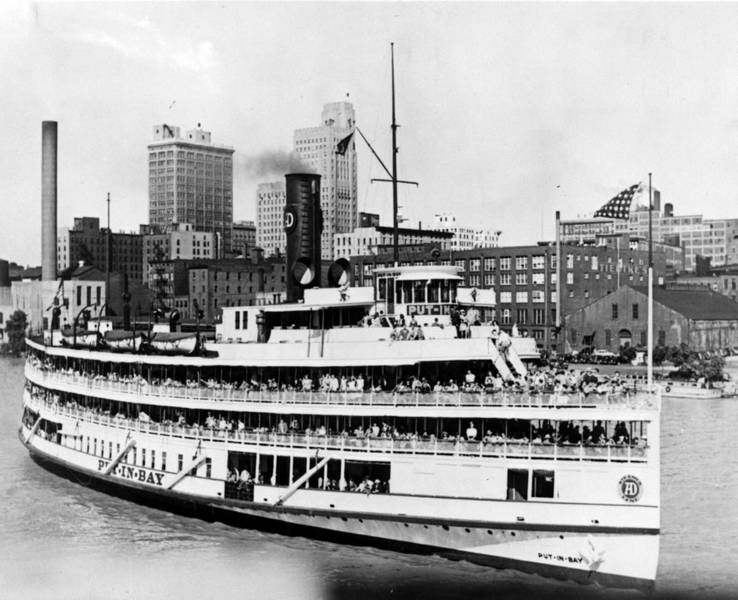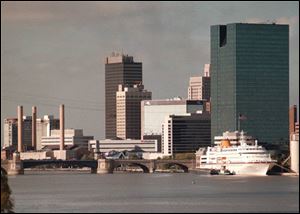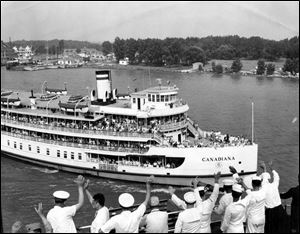
A proposal that could hold water
7/18/2006
The Put-In-Bay was one of the many passenger vessels that called on Toledo in the early 20th century.
If we build it, will they come?
That question applies not only to sports facilities but also to Toledo's planned $3 million passenger-ship terminal on the Maumee River.
Will the cruise-line and excursion-boat operators put Toledo on their itineraries? Will there be enough customers to revitalize what was once a thriving industry in these parts?

The 420-passenger MV Columbus was one of the cruise ships that occasionally visited Toledo in the 1990s.
Whatever happens there's little chance of regaining the glory days, when numerous steamships, or "steamers," carried thousands of passengers daily from downtown Toledo to nearby places like Perrysburg and Maumee Bay and also to such distant locations as Put-in-Bay, Cedar Point, Detroit, Windsor, Cleveland, and Buffalo.
Those grand vessels, some capable of carrying more than 3,000 passengers, also carried Toledoans a century ago to casinos, night clubs, resorts, and amusement parks.
But they gradually disappeared after World War I because of automobiles, electric trains that thrived for several decades, and, of course, Prohibition, which took much of the fun out of excursions on Lake Erie and the Maumee River.
But some folks think cruises and excursions could make a comeback.

The steamship Canadiana took passengers between Toledo and Bob-Lo Island.
"The cruise industry [on the Great Lakes] is growing, and having a facility here gives us a leg up," said Jim Hartung, president of the Toledo-Lucas County Port Authority. "We have some marketable attractions."
Kelly Rivera, special projects manager for the port authority, said plans for the terminal are being completed by Poggemeyer Design Group, of Bowling Green, and the structure could be finished in two years.
It would be funded by a federal ferry grant of nearly $2.5 million and $611,000 from the port authority.
She envisions ferry service to the Lake Erie islands, Detroit, Windsor, and Maumee Bay by 2008 and cruise-ship operation by early 2009.
Attempts to revive the cruise-ship industry here - in the late 1960s, the mid-1970s, and as recently as the mid and late-1990s - were hampered because "we always operated out of makeshift terminals," she said.

The Put-In-Bay was one of the many passenger vessels that called on Toledo in the early 20th century.
But, she added, the business is there for the taking.
Bob McCarthy, longtime owner of a local excursion boat - the 48-passenger Arawanna II - said, "This is a natural, and untapped market. But it's like anything else: It all depends on the marketing."
He suggested that itineraries could be imaginative, such as a weekend cruise from Toledo to Detroit, through the Soo Locks, Lake Superior, and Lake Michigan, ending in Chicago, followed by an airplane flight back to Toledo.
"The trip to Detroit and Lake Huron is stunningly beautiful," he said.
Excursions in the 1950s were on the Canadiana, the last steamship that regularly took passengers in Toledo, he said. The ship, which could hold as many as 2,270 passengers and a crew of 38, made daytime runs to Bob-Lo Island in Detroit and nightly moonlight trips to Toledo Harbor Light and back.
But in the late 19th century and the early part of the 20th century, the river, bay, and lake were alive with vessels.
For example, there were the Greyhound, a 387-foot-long steamer that carried as many as 3,366 passengers; the Put-in-Bay, which was designed for 3,500 passenger but licensed for 2,800 (it had an 8,000-square-foot maple dance floor); and the City of Toledo, which gained some national fame when it was pressed into duty to ferry thousands of passengers from downtown Chicago to the Chicago World's Fair of 1893.
In recent decades, the biggest boat that regularly cruised in this area was the Arawanna Queen, which could handle 375 customers for dinner cruises in the 1980s.
In the late 1990s, several cruise ships visited Toledo but did not put the city on regular schedules. Among them were the 420-passenger MV Columbus and the 100-passenger Nantucket Clipper. Both of those are likely candidates for Toledo cruises in the future.
Even if the glory days of cruises are gone forever, it would be fun, and potentially financially rewarding, for Toledo to experience a revival of this once-great industry.
Homer Brickey is The Blade's senior business writer.
Contact him at:
homerbrickey@theblade.com
or 419-724-6129.